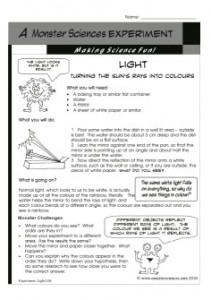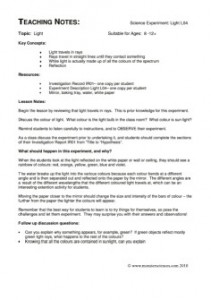Find your own rainbow in normal sunlight. Discover the spectrum!
 |
 |
Monster Sciences Light Science Experiment: Make a rainbow
What you will need:
- A baking tray or similar flat container
- Water
- A mirror
- A sheet of white paper or similar
What you will do:
- Pour some water into the dish in a well lit area – outside is best. The water should be about 3 cm deep and the dish should be on a flat surface.
- Lean the mirror against one end of the pan, so that the mirror side is pointing up at an angle and about half the mirror is under the water.
- Now direct the reflection of the mirror onto a white surface, such as the wall or ceiling, or if you are outside, the piece of white paper. What do you see?
What is going on?
Normal light, which looks to us to be white, is actually made up of all the colours of the rainbow, literally. The water helps the mirror to bend the rays of light, and each colour bends at a different angle, so the colours are separated out and you see a rainbow.
Monster Challenges:
- What colours do you see? What order are they in?
- Move your experiment to a different area. Are the results the same?
- Move the mirror and paper closer together. What happens?
- Can you explain why the colours appear in the order they do? Write down your hypothesis, then do some research to see how close you were to the correct answer.
Teaching Notes: Monster Sciences Experiment: Light L04
Topic:
Light
Key Concepts:
- Light travels in rays
- Rays travel in straight lines until they contact something
- White light is actually made up of all the colours of the spectrum
- Reflection
Resources:
- Investigation Record IR01– one copy per student
- Experiment Description Light L04– one copy per student
- Mirror, baking tray, water, white paper
Lesson Notes:
Begin the lesson by reviewing that light travels in rays. This is prior knowledge for this experiment.
Discuss the colour of light. What colour is the light bulb in the class room? What colour is sun light?
Remind students to listen carefully to instructions, and to OBSERVE their experiment.
As a class discuss the experiment prior to undertaking it, and students should complete the sections of their Investigation Report IR01 from ”Title to “Hypothesis”.
What should happen in this experiment, and why?
When the students look at the light reflected on the white paper or wall or ceiling, they should see a rainbow of colours: red, orange, yellow, green, blue and violet.
The water breaks up the light into the various colours because each colour bends at a different angle and is then separated out and reflected onto the paper by the mirror. The different angles are a result of the different wavelengths that the different coloured light travels at, which can be an interesting extention activity for students.
Moving the paper closer to the mirror should change the size and intensity of the bars of colour – the further from the paper the lighter the colours will appear.
Remember that the best way for students to learn is to try things for themselves, so pose the challenges and let them experiment. They may surprise you with their answers and observations!
Follow up discussion questions:
- Can you explain why something appears, for example, green? If green objects reflect mostly green light rays, what happens to the rest of the colours?
- Knowing that all the colours are contained in sunlight, can you explain



